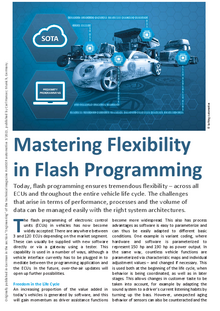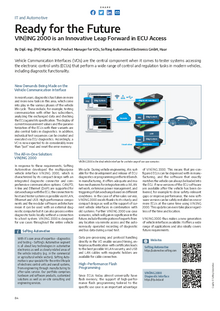Softing SDE – Smart Diagnostic Engine
Platform-Independent Runtime System for Diagnostic Functions, Sequences and Services over the Entire Life Cycle.
Softing´s Smart Diagnostic Engine (SDE) is a high-performance runtime system which interprets and runs simple diagnostic services and complex as well as automated diagnostic sequences. It is based on the Softing Diagnostic Base System and uses the standardized diagnostic formats ODX and OTX and extends these with an easy-to-operate, functional API. The SDE, which can be used modularly and independently of the platform, is implementing a paradigm shift in diagnostics. The additional Smart Diagnostic API (SDA) focuses on the function-oriented application of diagnostics without requiring in-depth diagnostic knowledge. Simultaneously, the SDE makes it possible to access the API interface ‘remotely’. At the same time it continues to support all relevant diagnostic protocols and bus systems. The fact that it does not depend on a specific platform results in continuous reusability in the product life cycle. A wide variety of vehicle interfaces and the corresponding diagnostic protocols can be integrated using the D-PDU API.
Areas of Application
- Engineering: as the basis for diagnostics or programming for test systems in the lab, on test assemblies or in engineering fleets
- Testing: as an independent automation component integrated in test benches or HiL test systems
- Manufacturing: as an end-of-line update and test system, for automated programming stations or in independent flash applications during vehicle shipping
- After Sales: integrated in the repair shop tester or as a component for diagnostics in the back end
- In-vehicle: as a diagnostic tester or programming application which rides in the vehicle
Advantages
- A single component for diverse requirements of today’s diagnostic tasks
- Can be used widely thanks to various APIs for different use cases: easy learning and wide parameterization in one solution!
- Platform-independent use of the SDE under Windows, Linux, Android and iOS throughout the life cycle
- Remote access and thus future-proof use for, e.g., SOTA use cases
- Depending on the degree of automation, can be used with or without user interface, including wide technology support, e.g. for C++, C#, Java
- Continuous reuse of diagnoses, projects and sequences already created
- Integration of components already available, even external ones, such as Java Jobs
- High-performance diagnostics thanks to special, ultra-compact runtime format – also for increased security requirements with customized encryption
Do you have questions about our solutions or need support?
Please contact us – we are pleased about your interest!
Areas of Application: Tools, Cloud and Vehicle
Softing SDE is a scalable, platform-independent diagnostic runtime environment. Generally speaking, a distinction can be made between three areas of application.
Tools
Softing SDE is used in all kinds of tools during the entire vehicle life cycle. These can be applications with a strong GUI focus, in other words a focus on the diverse operation by the user, such as engineering or repair shop testers. But Softing SDE is also ideal in any automation solution from function testers and HiL in engineering through to programming and testing solutions in manufacturing. Alongside the variety of the APIs, the consistent use of data is a major advantage.
In-Vehicle
Due to its narrow footprint, Softing SDE is also used directly in the vehicle. In engineering and development vehicles, this is particularly the case in data loggers and external telematics units. TCUs (Telematics Control Units) or head units are usually used in series production vehicles depending on the architecture. Softing SDE is used here, among other things, as a stand-alone programming unit or as a local diagnostic tester that can also be addressed remotely.
Cloud
Alongside remote solutions, which ideally lengthen the connecting line between the tester and the VCI, Softing SDE is increasingly being used in cloud solutions. This is where the scalability of the solution fully utilizes its advantages: Depending on the particular use case, the runtime environment can be integrated into the tester, installed in the cloud or be available in the vehicle. The test solution can be operated interactively by the user or run automatically in the cloud, for example in the sense of a fleet health state. The limits here are set by the technical boundary conditions.
Functions
- Vehicle QuickTest incl. status report
- ECU variant identification
- Reading out and clearing the error memory (DTC)
- Exchange and (re-)programming of ECUs
- ECU coding
- Reading out and saving measurement values using diagnostic services
- Setting and evaluating actuators
- Automating flash processes and function tests (with and without UI)
Overview
ODX/OTX runtime system
Incredibly High-Performance, Low System Requirements, with UDS, OBD and J1939 Sample Templates.
The SDE is a high-performance runtime system which serves both diagnostic communication over individual services (ODX) and complex diagnostic sequences (OTX) extremely efficiently. The support of all standard diagnostic protocols and standards, such as UDS, DoIP, J1939, KWP, OBD and D-PDU API, as well as the bus systems CAN/CAN FD, Ethernet and LIN over Vehicle Communication Interfaces (VCI) is part of the basic scope of the SDE. Simulated communication over a virtual interface is also available for first tests. Depending on the VCI used, the SDE enables parallel communication with several ECUs. This facilitates the simple parallel flashing of ECUs, for example.
Thanks to its low system requirements and high performance, the Softing SDE is not only suitable for PC use but also for embedded systems. The runtime formats also contribute to this. These are used depending on the required data process and also offer extreme data reduction.
The delivery scope includes templates and examples for an even simpler and faster use of diagnostics. These templates include a sample project for UDS on CAN and UDS on IP each with sample ECUs as well as templates for OBD and J1939 equipped with the current services defined in the standards. If required, these are very easy to adapt and extend.
Use Cases of SDE
HiL-Integration
Hardware in the Loop systems are used to verify ECU functions with real hardware (device under test, DuT) and a simulated environment. This involves a stimulus being applied to the DuT via the environment – for example using a sensor simulation – and the reaction being compared with the expected result. By integrating the Softing SDE into an HiL system, it is possible to use the diagnosis for both the stimulus and to verify the outcome. The stimulus can, for example, be the running of an ECU routine, this is verified by querying the internal status or error memory entries.
As an additional benefit, the Softing SDE also makes it possible to install new ECU software directly via the HiL system: No special tools are necessary.
Use in Manufacturing
In a vehicle manufacturer’s line stage, separate computers are often used for individual production line sections: In turn, these are controlled via a central computer. By integrating the Softing SDE in these production line section computers, diagnostic tasks can be executed locally – with or without the interaction of a production employee. This means, for example, that the powertrain ECUs can be programmed in one production line stage and the vehicle ECUs in the next. Control is either the task of dedicated programs, such as a flash application, or the master computer over the remote route. Other diagnostic tasks, such as coding, can also be taken care of via these production line section computers.
InVehicle
The trend is very obviously to move part of the diagnostic system into the vehicle. On the one hand, this facilitates an up-to-date statement on the state of the vehicle at all times, and, on the other, enables predictions on components or remote access. The Softing SDE can already be used in vehicles today due to its small footprint and the integrated strong data reduction. Typical applications currently are those in the vehicle with error memory access and for “over the air” programming (OTA). Further use cases include searching for errors via remote access and the mirroring of information in the cloud, for example for quality assurance measures.
Nice to know
Freedom in the Choice of APIs
Depending on the particular use case, Softing SDE provides access to diagnostics via various APIs. The SDA (Smart Diagnostic API) is a service-oriented interface in which entire diagnostic functions, such as a vehicle quick test, are implemented within Softing SDE and only have to be run by the application and have the results processed. This remote-capable API is easy to learn and can be integrated into various tools. Furthermore, it makes it possible to run OTX sequences.
The MVCI Server API in accordance with ASAM MCD-3D and ISO 22900-3 is used for expert systems. The engineer/developer can use it to access all data on the ODX database and parameterize diagnostic services in detail. The D-PDU API is used whenever only a few specific diagnostic services are required. It receives a hexadecimal byte stream. The ECU responses are also available in hexadecimal format. Knowledge of the actual diagnostic protocol is not required.
Diagnostics with High Data Security
The ODX data used can be processed securely with the Smart Diagnostic Engine. If required, the ODX database can be encrypted for a specific client so that only approved users can use this data. This is safeguarded with additional licensing information and protects corporate knowledge from unauthorized access. The same is true of the OTX scripts which can also be encrypted.
Monitoring for DoIP and Parallel Remote Access
Softing SDE is ready for the increasing use of Ethernet in vehicle communication. It is not only possible to record (trace) communication on tried and tested vehicle buses but additionally to monitor and also record the DoIP communication. The monitor at PDU level incl. an efficient message filter also improves user handling.
The possibility of establishing connections remotely has been taken into account in the Smart Diagnostic API functionality from the outset and is available for corresponding areas of implementation. The application is based on common standards from network technology. One key requirement is the multi-client scenario for simultaneously accessing several applications. Softing SDE detects and manages simultaneous calls without disturbing or interrupting important communication with a client.
Various Target Platforms in the Life Cycle
The SDE is implemented in C++ and can thus be made available for all platforms relevant today (Windows, Linux, Android and iOS). It is therefore not just an integral part of the DTS9 Windows applications (engineering tester) or Softing TDX (repair tester in After-Sales), but also implements diagnostics in the test bench or as an embedded version in vehicle TCUs, in data loggers and in Vehicle Communication Interfaces (VCI). Even mobile diagnostic applications can be implemented consistently with Softing SDE and in addition to applications and configurations already being used.
Do you have questions about our solutions or need support?
Please contact us – we are pleased about your interest!
Products





















